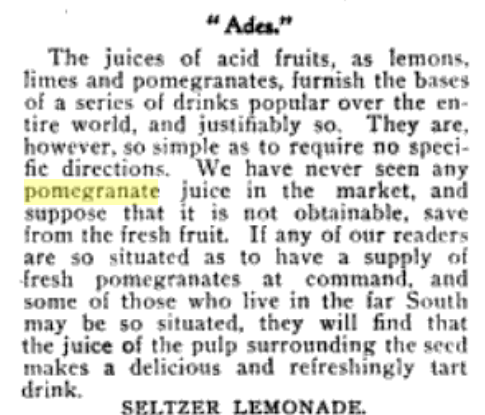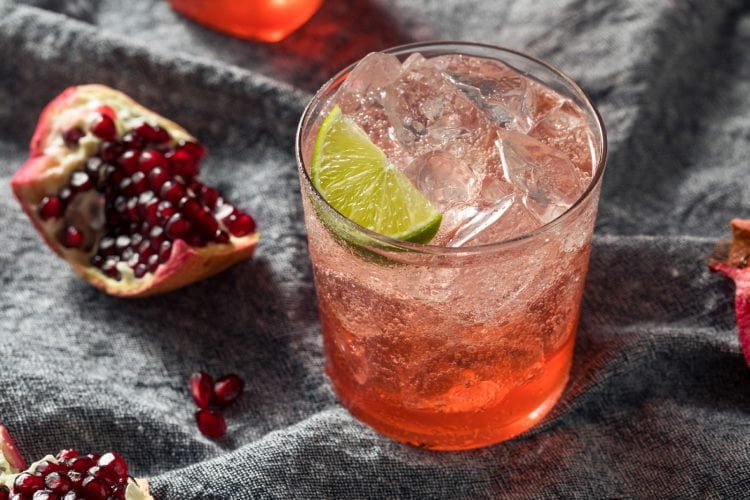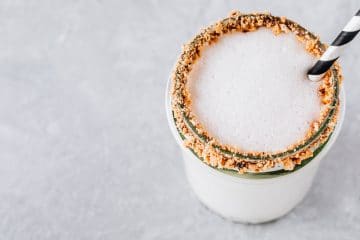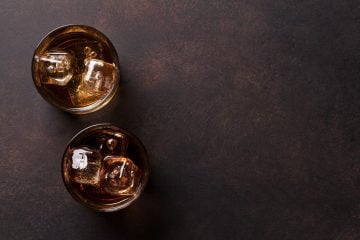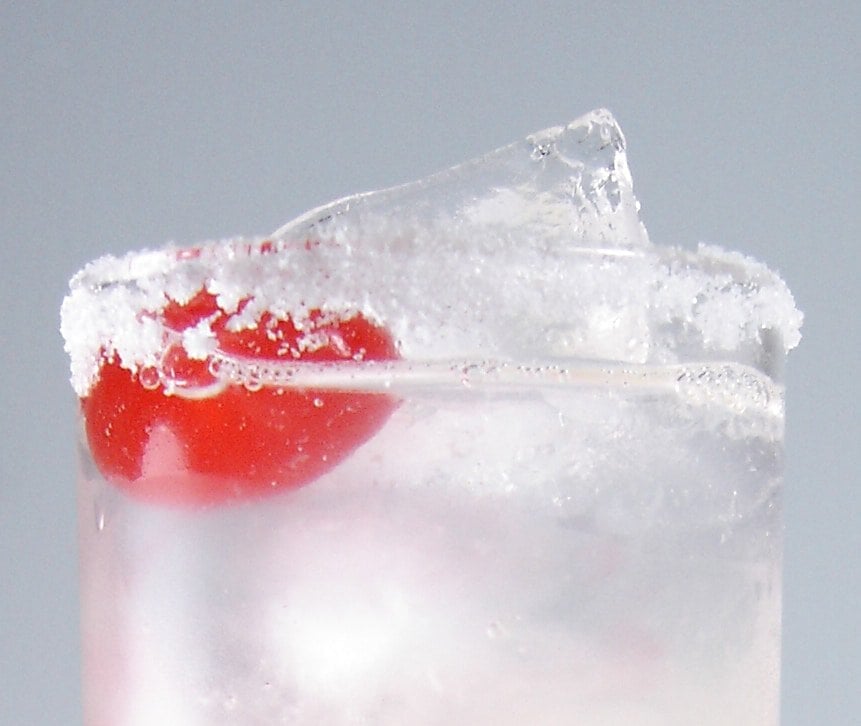What would you say if I told you the literal translation of grenadine from French didn’t mean pomegranate in the context of the sweet red syrup called grenadine? What would you think if I said modern grenadine is an over-simplified corruption of a once complex and interesting product? I’m sure you would be curious, so let’s break this down because it may turn your Tequila Sunrise upside down.
Most people know the bright red, sweet and sticky syrup we call grenadine, and other than being sweet and red doesn’t offer much to the enterprising drink mixer. It is mostly used to add bright red colour and a wallop of sugar to a drink. But 120 years ago, it was more interesting.
During the 2000s cocktail renaissance, bartenders took a closer look at this syrup and concluded that it shouldn’t just be “red simple syrup.” Taking the name literally, they believe they should make it from pomegranate juice, so everyone headed in that direction, myself included. And that was considered another cocktail problem solved by the community. That is until I started writing Fix the Pumps in 2009 when I stumbled upon an odd recipe for grenadine in The Standard Manual of Soda (1901). Life was busy, so I put it to the side to focus on other projects.
Camper English wrote a detailed post in 2012 on grenadine and made note that courts considered grenadine to be pomegranate because that was what the word meant in French. Camper even notes the recipe from The Standard Manual of Soda but doesn’t take it any further.
In 1870, there was a trademarked syrup called Grenade (French), but the court overturned the trademark because the word grenade was just a common French word for pomegranate…and that is where things go wrong. The assumption seems to have always been that grenade or grenadine must mean pomegranate, which is incorrect.
The Standard Manual of Soda (1901) has a unique recipe for grenadine that seems out of place in modern times since it is complex. In the early days of bars, bartenders were prone to keeping their popular recipes secret, but it was vital for pharmacists and chemists to document their discoveries and get them published. Gaining recognition in pharmacy journals for medical discoveries was important, but credit for an interesting soda drink was also part of their career development. Though 1800s medicine may seem simple by today’s standards, publishing research was just as important back then as it is today. It’s through these centuries of documentation that we can track how something as simple as grenadine developed, and yes, grenadine was a well-known pharmacy ingredient.
At the turn of the 20th century, grenadine started to make its way into cocktails. The first references come from Cocktail Boothby’s American Bartender, and then by the 1910s becomes more common. Before that, raspberry syrup and Red Curacao were the cocktail colourants of choice. Some of the cocktails that used grenadine include the Clover Club, Jack Rose, Bacardi Cocktail and even the Monkey Gland, but which version did they use? Everyone assumes it’s the pomegranate version, with no consideration to the local pharmacy that dealt with soda, syrup, bitters and better drugs than any bar could supply.
When I posted on Twitter that I thought the cocktail community got grenadine wrong, it stirred up some discussion and Anita at Married with Dinner asked the key question: “How do you explain the name, then? It literally means “pomegranate-y.“
Literal translations are not the best method for solving historical mysteries. I’ve been known to spend a few hours here and there reading old dictionaries from the 17th and 18th centuries. That’s where you find cool words like ale-knight and pandoratrix, but you can also see how words evolve, and if you like to write, that is important.
The other thing is having multiple interests. I like chemistry, history and gardening. Though the last one doesn’t sound important, it was the key to this discovery. As I was looking for a plant with clove-like flavours, I stumbled upon Clove-Pinks, a variety of Carnation. One of the synonyms for this flower is Grenadines, and they are crimson red* and have a clove-type aroma with a pleasant bitterness. In the description for the seeds, it mentioned that historically they used them in drinks. Boom, instant connection back to the recipe for grenadine in The Standard Manual of Soda. When we get to the recipe, you will note it has Oil of Cloves as an ingredient.
* Why are they called “pinks” if they are crimson? Thanks to Alyson Brown, I learned that it is the frilly edge of the flower that gives them the name, think of pinking shears that give material a sawtooth edge, that’s pinking.
Background Information: Grenadin Carnation
So the syrups name referred to the red colour, like a pomegranate, not the fruit.
This flower has many names throughout history, including gilofre (French for cloves), gillyflower (pronounced jilly), gilliver, Clove-Pink, Carnation, Clove-July flower, grenadine and scientifically as dianthus caryophyllus. Edmund Spencer in the Faerie Queene (1590) called them “sops-in-wine” because it was customary in those days to infuse this flower in drinks for the spicy flavour they bestow, which leads us to the fact that Clove-Pinks have a long history of being used in drinks.
If you want to take a further deep dive into this flower, check out this post on Medieval Mead & Beer, there is some excellent detail.
Clove-Pink Syrup or Syrup of Dianthus Caryophyllus was quite common in old pharmacy manuals. With a quick look, I found a published recipe in the 1788 edition of the Pharmacopœia Officinalis Britannica; though I suspect recipes will be found much earlier, for our purposes, this is good enough. These formulae were usually syrups made by infusing 1 pound of flower petals in 2 pints of hot water for 12 hours and then adding twice the weight of sugar to make a syrup. It was typically used as a vehicle to cover up the taste of bad medicine or provide colour. In wine, an ounce of petals in a pint of wine was typical, but they also added sugar to sweeten things up.
By the 2nd half of the 19th century, chemists were fully committed to making extracts and essences because they were more shelf-stable and tasted similar to the article they were trying to reproduce. For example, a clove-pink extract could be produced as follows:
Extract of Clove Pink
Druggist’s handbook of private formulas. John Nelson, 1882
Spirit of Rose, 2 ounces;
Spirit of Cassia, 1/2 ounce;
Spirit of Tonka Bean, 1/2 ounce;
Oil of Cloves, 10 drops;
Cologne Spirit, 16 ounces.
These formulas often saw double duty, some being used in medicine and sometimes being used as a handkerchief perfume. If you compare the above formula with the grenadine one from the Standard Manual of Soda, you will see some similarities, mostly clove, vanilla/tonka (roughly the same thing) and a floral element, in this case, Spirit of Rose.
In the American Druggist and Pharmaceutical Record, Volume 23 (1893), a formula for Pomegranate Syrup is as follows:
Pomegranate Syrup (1893)
3 parts Oil of sweet orange
7 parts Oil of clove
15 parts Tincture of vanilla
10 parts Tincture of ginger
150 parts Maraschino liquor
165 parts Tincture of coccionella
150 parts Distilled water
46 parts Phosphoric acid dilute
810 parts Alcohol 95%
Mix and dissolve. To make the syrup add 1 part of the essence to 50 parts of simple syrup and dissolve in the mixture one part of citric acid.
As you will note, there is no pomegranate in this recipe, but there is clove, vanilla and floral (orange) and spicy elements (ginger). When you see The Standard Manual of Soda’s recipe for Grenadine Essence, it is impossible not to correlate that this is what they considered grenadine at the time.
Grenadine Essence or Extract (1901)
Oil of cloves, drops 6
Oil of orange peel, drops 18
Tincture of ginger, fl dr 1
Vanilla extract, fl dr 1½
Diluted phosphoric acid, fl dr 4
Maraschino liqueur, fl oz 2
Tincture of cochineal, fl oz 2
Distilled water, fl oz 2
Alcohol enough to make fl oz 16
*fl dr = fluid drams
By 1916, the Manual for the Essence Industry has the following recipe for grenadine.
GRENADINE Basic ETHER (1916)
Clove Oil….6 drams
Honey Flavor Oil….12 dr
Ceylon Cinnamon Oil…..14 dr
Nerolin…..1½ oz.
Petitgrain Oil….2½ oz
Benzoyl Benzoate…..10 oz
Peach Flavor Oil…..¾ lb
Amyl Valerate……1¼ lb
Amyl Acetate……1½
Ethyl Acetate…..3½
The essence still has the clove, nerolin and petitgrain would be floral orange blossom aroma, the cinnamon oil matches the 1882 Clove-Pink cassia, and the rest contribute fruity or spicy flavours. These recipes would be wholesaled by essence companies with directions on diluting and colouring to produce the final product.
By the time we get to 1936, the Flavours and Essences: A Handbook of Formulæ by M.H. Gazan, the recipes for grenadine forgo the clove and pretty much go all fruit flavours from artificial sources. This may have been a circumstance of prohibition, much like how complex cocktails turned into sweet, creamy concoctions by the 1950s.
Grenadine Essence A (Pomegranate)
Raspberry Essence – 1175 cc
Pineapple Essence – 150 cc
Orange Essence – 50 cc
Lemon Essence – 25 cc
Pomegranate Essence – 100 cc
Vanillin – 20 g
The evolution of grenadine from a natural syrup made from Clove-Pinks, which had an aromatic, spicy, floral, clove flavour, to a fruit-flavoured syrup was part evolution and part mistaken identity. Chemists in the 1800s wanted extracts because they were easy to make, stable and didn’t require farmers to grow vast quantities of flowers. Etymology and literal translations confused, and prohibition probably didn’t help keep the recipe true. Because chemists have excellent documentation, there is a direct line from the 1700s Syrup of Dianthus Caryophyllus to Extract of Clove-Pink to Pomegranate Syrup to Grenadine Syrup, all uniquely connected by the clove aroma, floral notes, orange and vanilla and the colour red.
For pre-prohibition cocktails made with grenadine, this changes things. The Bacardi Cocktail with modern grenadine is lame, but if you look at the 1901 recipe for grenadine with cloves, vanilla, orange, ginger, phosphoric acid (Acid Phosphate will work too), and Maraschino, it might be the defibrillator that gives this drink a zap of redemption. More importantly, the Clover Club, Jack Rose, Ward 8 and Monkey Gland and others might be given whole new perspectives, and that I like, because my thing has always been about tasting history, and I want to taste it properly.
As for your Tequila Sunrise, it is firmly in the modern grenadine camp, so you don’t need to make Dianthus Caryophyllus Syrup, but you know it would probably taste better with it. Am I right?
Update (March 1, 2021): In the context of this article, this grenadine preparation would have only been used in cocktails from 1900 to prohibition. After prohibition, most companies were marking grenadine from a number of artificial sources. And tiki drinks were not affected by this because Trader Vic specifically called for pomegranate grenadine.
Update (Feb 26, 2021): To clarify, pomegranate syrup did exist in the 1800s and in France was definitely called Grenadine Syrup as was pointed out by David Wondrich (peer review is good). This product was also imported into the United States, however, it was not a common product of commerce because it was expensive to ship and local companies could produce artificial grenadine syrups which were cheaper and more accessible and didn’t turn brown with age. In the context of cocktails, the artificially produced grenadine syrups were more common and most likely used in cocktails.
